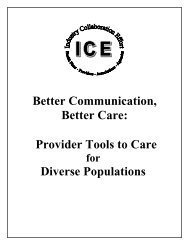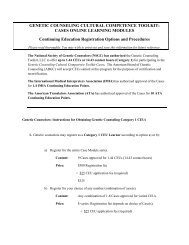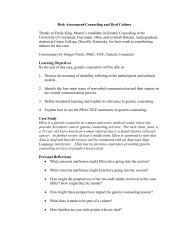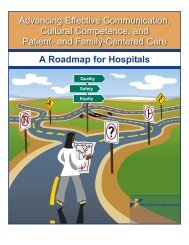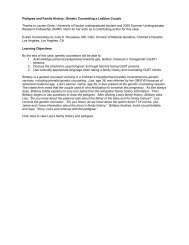making the business case for culturally and linguistically appropriate ...
making the business case for culturally and linguistically appropriate ...
making the business case for culturally and linguistically appropriate ...
Create successful ePaper yourself
Turn your PDF publications into a flip-book with our unique Google optimized e-Paper software.
hospital’s <strong>culturally</strong> diverse patient populations. This realization <strong>and</strong> commitment to culturalcompetency led to <strong>the</strong> development of a master facility plan that called <strong>for</strong> 68 privatematernity suites to serve a diverse population of women <strong>and</strong> <strong>the</strong>ir families. However, whatwas targeted to promote <strong>culturally</strong> competent care <strong>for</strong> minority populations was also anattractive option <strong>for</strong> <strong>the</strong> full range of patients who give birth at Holy Cross. Growth inobstetrics volume among all patients who come to Holy Cross led to overall volume growth<strong>and</strong> improved financial per<strong>for</strong>mance <strong>for</strong> <strong>the</strong> hospital.• Language Access ServicesLanguage services are <strong>the</strong> front line of CLAS. Language barriers, in <strong>the</strong> absence of adequateinterpretation <strong>and</strong> lack of translated patient in<strong>for</strong>mation <strong>and</strong> materials, preclude <strong>the</strong> provisionof equitable, quality health care. Language interpretation errors between health careproviders <strong>and</strong> LEP patients have resulted in dangerous <strong>and</strong> costly consequences. CLASSt<strong>and</strong>ards 4 through 7 outlines <strong>the</strong> <strong>linguistically</strong> <strong>appropriate</strong> services <strong>for</strong> health careorganizations serving patients with limited English proficiency.As is <strong>the</strong> <strong>case</strong> nationally, <strong>the</strong> CLAS projects included in this report use a variety ofapproaches to assure adequate language services. Perhaps because <strong>the</strong>re are many morelanguage services initiatives from which to choose, it was easier to find <strong>the</strong>se <strong>case</strong>s, describe<strong>the</strong>m, <strong>and</strong> present more robust documentation about <strong>the</strong>ir successes. Finding ways to provide<strong>appropriate</strong> <strong>and</strong> thorough language services while simultaneously managing <strong>the</strong> costs ofthose services is a common <strong>the</strong>me. The <strong>business</strong> <strong>case</strong>s <strong>for</strong> Contra Costa (Remote Video/VoiceMedical Interpretation Project), Holy Cross Hospital (Volunteer Interpretation Project <strong>and</strong>Group Discharge Classes in Spanish), L.A. Care Health Plan (Health Care InterpretationProject), <strong>and</strong> The Young Children’s Health Center (Bilingual Employee Incentive Program)all provide examples of how <strong>the</strong> implementation of language access services resulted inquantitative <strong>and</strong> qualitative <strong>business</strong> benefits <strong>and</strong> outcomes.Contra Costa Health Services (Martinez, CA)Be<strong>for</strong>e 2005, Contra Costa Health Services relied on 16 full-time bilingual employees <strong>and</strong>one full-time supervisor to provide language interpretation services throughout its health caresystem. To meet <strong>the</strong> language interpretation needs of <strong>the</strong> service population, Contra CostaHealth Services also contracted with two major language services agencies at an annual costof over $200,000 <strong>and</strong> rising. In an attempt to manage <strong>the</strong>se language costs better <strong>and</strong> toassure <strong>culturally</strong> competent care <strong>for</strong> <strong>the</strong> limited English proficient (LEP) population atmultiple sites on a 24 hour basis, Contra Costa Health Services partnered with three Nor<strong>the</strong>rnCali<strong>for</strong>nia county hospitals (Contra Costa, San Mateo, <strong>and</strong> San Joaquin) in <strong>the</strong> creation of <strong>the</strong>Health Care Interpreter Network (HCIN). The network developed <strong>the</strong> remote video/voicemedical interpretation (RVVMI) project to provide language translation services to patientsat <strong>the</strong>ir bedside. The RVVMI is a model of shared interpreter services utilizing <strong>the</strong> mostadvanced video <strong>and</strong> voice-over internet protocol (IP) technologies to complement in-personinterpretation. Contra Costa Health Services sought to integrate <strong>the</strong> remote video/voice callcenter systems throughout its organization <strong>and</strong> to provide <strong>the</strong> lowest-cost, highest qualityinterpretation services at all Contra Costa Health Services care venues.The project’s initial price <strong>for</strong> <strong>the</strong> exchange of language service among <strong>the</strong> tri-partnership was$.75 cents per minute as compared to Contra Costa’s previous pricing <strong>for</strong> contractinterpretation services at a rate of $1.55 per minute (cost savings of $0.80 per minute). In14




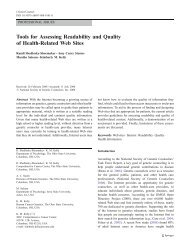

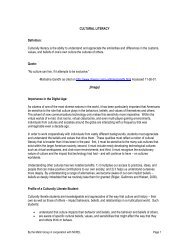
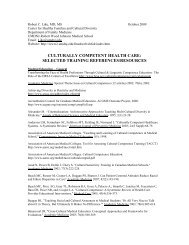

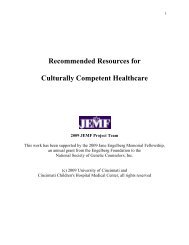
![Breaking Bad News PPT[1] - Genetic Counseling Cultural ...](https://img.yumpu.com/35003134/1/190x146/breaking-bad-news-ppt1-genetic-counseling-cultural-.jpg?quality=85)
